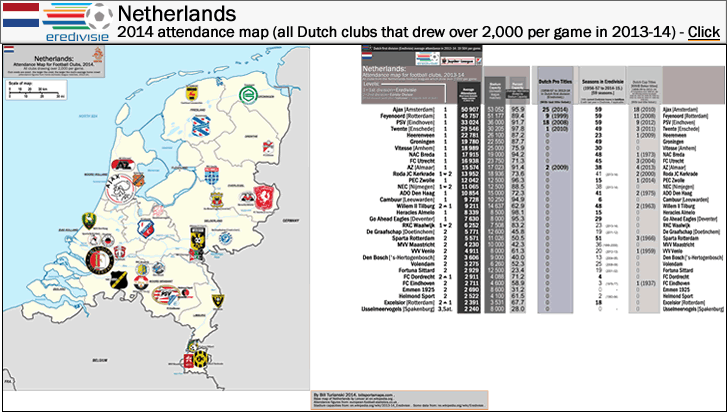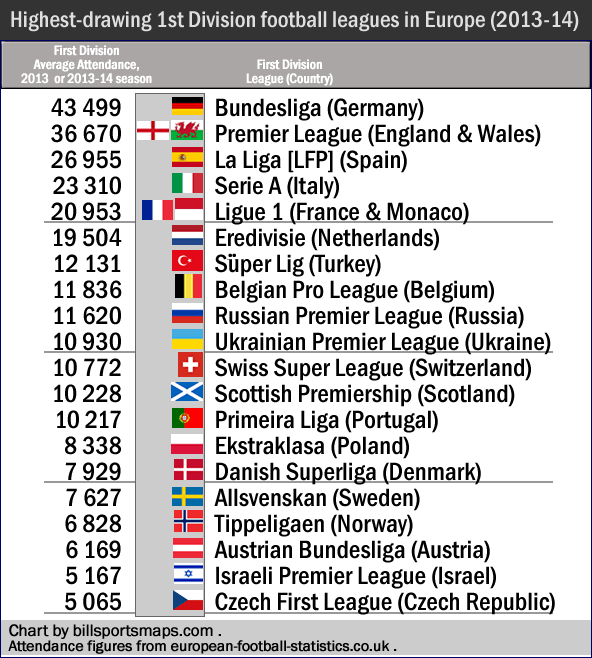
Netherlands: 2014 football attendance map, all Dutch clubs [32 clubs] drawing over 2 K per game
…
…
This continues my category of European leagues – attendance maps. Last season [2013-14], Netherlands had the 6th-highest average attendance for its first division in Europe (see chart below). The top five in Europe for 2013-14 I have done previously {here: Germany, England, Spain, Italy, France).
Below – Chart: the 20 highest drawing association football leagues in Europe

Source of data, http://www.european-football-statistics.co.uk/attn.htm.
…
Elements of the map page
The cut-off for clubs on this map is 2,000 per game average attendance, unlike the first five I did in this style, which had a cut-off of 4,000 avg. attendance. The reason I did it this way for Netherlands is basically because I could (could fit them all in the map, that is). There are 32 clubs on the map (all 18 Eredivisie clubs from last season; 13 of the 20 clubs from the Dutch 2nd division; and 1 of the 32 semi-pro teams in the Dutch 3rd division). Had I done the map in the 4-K-cut-off-style, there would have been 23 clubs (23 clubs in Netherlands drawing over for 4 K per game in 2013-14). That is not too shabby. Netherlands only has around 16.8 million inhabitants, yet it still is able to maintain a leagues system that has at its apex a league (the Eredivisie) which draws 19.5 K per game, which is only slightly lower than a nearby country with more than three-times the population – France. France, which has a population of around 66.6 million, has a top flight, Ligue Un, which averaged 20.6 K per game in 2013-14 (or only 1,125-more-per-game than the Netherlands’ top flight). In fact two seasons ago [2012-13], the Eredivisie was outdrawing Ligue Un (19,619 vs. 19,211).
Listed for each club, at the chart at the far-right-hand side of the map page, are: average attendances (from home league matches in 2013-14), stadium capacities, percent-capacities, Eredivisie titles, seasons spent in the Eredivisie by team, and KNVB Beker (Dutch Cup) titles.
On the map are shown are the 12 provinces of European Netherlands; they are listed in the Dutch. With only about 50% of its land exceeding one meter above sea level, the Dutch people have spent the last four centuries (successfully) keeping the Sea at bay. And so, because the Dutch are second-to-none at land-and-water management, I decided to include waterways on the map – so prominent bodies of water including rivers and canals (kanals) are shown and listed. I listed them also in the Dutch.
[{Here is a map of the Rhine River, Map of the Rhine basin (by WWasser at en.wikipeia.org).} In case you might be confused (and man, was I confused), the Rhine (Rijn, in the Dutch) flows from its source in the southeastern Swiss Alps near the Austria/Liechtenstein border, north to Lake Constance (depending on the lake's water level, the flow of the Rhine's water is clearly visible along the entire length of Lake Constance, which is a large Alpine lake which sits on the eastern part of the Swiss/German border including a portion that is in far-west Austria), and then as it emerges from the western edge of the lake, the Rhine continues to form the Swiss/German border all the way to the Swiss city of Basel, then at Basel the Rhine swings northerly and forms part of the French/German border, flowing past Strasbourg, then near the southwestern German city of Karlsruhe it continues to flow north but ceases to be part of the Franco/German border as it flows into southwest and west-central Germany (aka the Rhineland) as the Lower Rhine, then it swings west into the Netherlands...where, just west of Arnhem it is diverted into three distributaries: the Waal River, the Nederrijn ("Nether Rhine") and the IJssel; then the Nederrijn's name changes to the Lek as some of the Rhine's volume passes through Europe's largest shipping port at Rotterdam, then via the Nieuwe Waterweg ("New Waterway"), into the North Sea. But the Rhine's course through the Netherlands is way more complicated than that...
{excerpt from Rhine/Delta at en.wikipedia.org}..."From here, the situation becomes more complicated, as the Dutch name Rijn no longer coincides with the main flow of water. Two thirds of the water flow volume of the Rhine flows farther west, through the Waal and then, via the Merwede and Nieuwe Merwede (De Biesbosch), merging with the Meuse, through the Hollands Diep and Haringvliet estuaries, into the North Sea. The Beneden Merwede branches off, near Hardinxveld-Giessendam and continues as the Noord, to join the Lek, near the village of Kinderdijk, to form the Nieuwe Maas; then flows past Rotterdam and continues via Het Scheur and the Nieuwe Waterweg, to the North Sea. The Oude Maas branches off, near Dordrecht, farther down rejoining the Nieuwe Maas to form Het Scheur. The other third of the water flows through the Pannerdens Kanaal and redistributes in the IJssel and Nederrijn."... {end of excerpt}.]
___
Thanks to Lencer at en.wikipedia.org, for the blank map of Netherlands, File:Netherlands location map.svg.
Thanks to Alphathon at commons.wikipedia.org, for provinces/waterways map of Netherlands, File:Map provinces Netherlands-nl.svg.
Thanks to worldcanals.com/english/netherlands.html.
Thanks to European-football-statistics.co.uk, for Dutch attendance figures, http://www.european-football-statistics.co.uk/attn.htm.
Thanks to the contributors at ne. and en.wikipedia.org, at 2014–15 Eredivisie.
